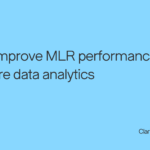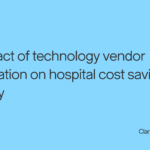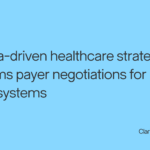When it comes to healthcare price transparency data, stepping into the world of healthcare cost and pricing often feels like navigating a labyrinth. So, the audience at the recent HIMSS 2023 in Chicago was grateful when Clarify Health’s Chief Analytics and Privacy Officer Niall Brennan, who is also head of the Clarify Health Institute (CHI), the research arm of Clarify Health, unpacked the complexities of this crucial topic during his presentation, “The Price is Right (or is it?): Decoding Transparency Data,” offering a deep dive into the evolution of price transparency efforts over the past decade. In doing so, Brennan shed light on the significant effects of new CMS rules on the disclosure of pricing for healthcare services, giving a fresh perspective on price transparency data and its applications. Brennan outlined the timeline of price transparency efforts, highlighting significant milestones and recent regulatory changes that are leading to improved visibility in negotiated healthcare pricing between payers and providers. He touched on the differences between hospital- and payer-reported rates, examining how data sources vary in content and quality. While Clarify is compiling both hospital -and payer-sourced price transparency data, payer-sourced data is generally provided for a broader set of services, for a greater number of providers including healthcare professionals, and employs a standardized data schema. As noted in our December 2022 brief, a significant challenge in the price transparency landscape is the sheer volume and complexity of data that needs to be compiled, processed, and enriched. Payers have posted millions of machine-readable files (MRF). Clarify simplifies the consolidation of these files with specific web scraping processes and applies relevant categorization for over 65 national and regional payers. Moreover, nuances exist for specific payers. For example, while the Blue Cross Blue Shield (BCBS) association shares a set of national rates and posts these across payers, each local payer posts data slightly differently, and the BlueCard program and other cross-payer reciprocity further complicate matters. Obtaining other payers’ MRFs present other obstacles, such as throttling or blocking data downloads, incorrect download links, and non-compliance with the CMS schema, requiring manual clean-up before processing and enrichment by Clarify. In addition, the sheer size of the payer price transparency data, estimated at over 6 trillion rates and counting, necessitates using cloud-based processing resources and capabilities unavailable to most organizations, let alone individual patients. Reported rates can apply to thousands of plans and hundreds of thousands of providers, containing massive amounts of duplication, inconsistent or incomplete reporting practices, and prices unassociated with actual provider volume. To meaningfully use the data, it must be further enriched by joining it with provider and health system identifiers and characteristics, identifying plan contracting groups, plan types, and employer affiliations, categorizing service lines, estimating rates as a percentage of local Medicare payments, and combining the payer rate data with commercial claims data to assess utilization. Clarify has found that the data can be frustratingly incomplete in some cases, providing only limited direct comparisons to aid competitive reimbursement discussions when comparing the same services in a similar geographic region. The map below shows claims volume-weighted, all-payer coverage estimates demonstrating wide variation in the availability of negotiated rate agreements with payers across inpatient services. Key factors in these calculations include the total number of distinct Medicare Severity Diagnoses Related Groups (MS-DRGs) that local hospitals bill, the number of payers publishing negotiated rates for that hospital, and the number of MS-DRGs for which they have a rate agreement with a specific payer. Clarify coverage estimates also adjust for payers’ market presence, excluding payers with minimal or no operations in a particular state. While the breadth of coverage across healthcare organizations provided by payer rates is high, digging into reporting by individual payers highlights gaps. Further complicating matters, payers also use catch-all coding to report negotiated rates across multiple billed service codes through a single record. Under the CMS schema, the code type CSTM-ALL “represents all possible coding types under the contractual agreement” while the service code CSTM-00 “represents all possible billing code values for the defined billing_code_type”. Used in combination, this reporting style means that for all codes not otherwise defined, the rate reported for code type CSTM-ALL and code CSTM-00 applies. An intriguing aspect of the transparency data is Clarify’s identification of rampant “zombie rates” – irrelevant pricing data unassociated with actual utilization – and the challenges they pose to the analysis of negotiated rates. Clarify’s strategies for identifying and eliminating these rates for improved decision-making processes were also discussed. Despite these complications, Brennan’s presentation next highlighted how analysts can nonetheless use enriched price transparency data to document substantial variation in commercial pricing of healthcare services. presented at HIMSS across inpatient service lines offers valuable insights into the distribution of commercial healthcare service prices relative to Medicare Fee-for-Service (FFS) payments. The figure below demonstrates the variation across inpatient service lines for MS-DRGs. These estimates are consistent with multiple prior studies leveraging different data sources, validating this application of payer price transparency data and highlighting significant variations in healthcare pricing. For example: Brennan concluded his session with a look at the future of price transparency, discussing the potential implications of increased data availability on commercial rate negotiations and the potential benefits for hospitals, payers, and patients. As payer price transparency data improves over time and coverage gaps are filled, industry stakeholders must consider whether the available data can address their specific use cases and inform decision-making processes. Brennan highlighted several challenges and questions surrounding applications of price transparency data, including: Addressing these challenges will be crucial for the healthcare industry as it moves toward a more transparent and efficient healthcare system. By refining data collection, reporting practices, and analysis methods, healthcare stakeholders can better leverage price transparency data to inform commercial negotiations, healthcare pricing policy development, and the delivery of patient-centered care. As the industry continues to evolve and becomes more data-driven, the potential for improved decision-making, better negotiations, and, ultimately, more value for patients will continue to grow. Niall Brennan leads the company’s analytics and informatics strategy. Additionally, as head of the Clarify Health Institute, Brennan and his team leverage Clarify’s data assets to provide thought leadership on important policy issues and establish research partnerships with academics and policymakers across the industry. Decoding Healthcare Price Transparency Data
Assessing Payer-Reported Rates Coverage
Analysis and Applications of Healthcare Price Transparency Data
The Future of Price Transparency Reporting and Use
- Author Details





